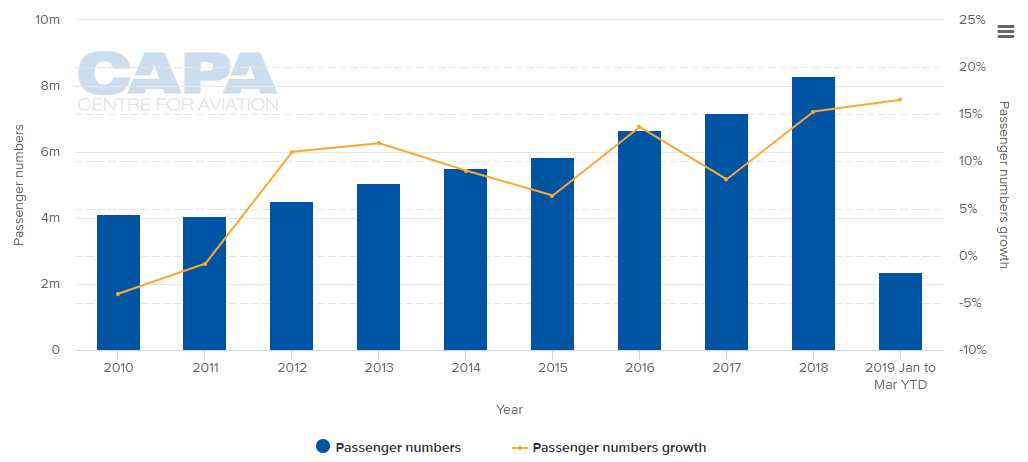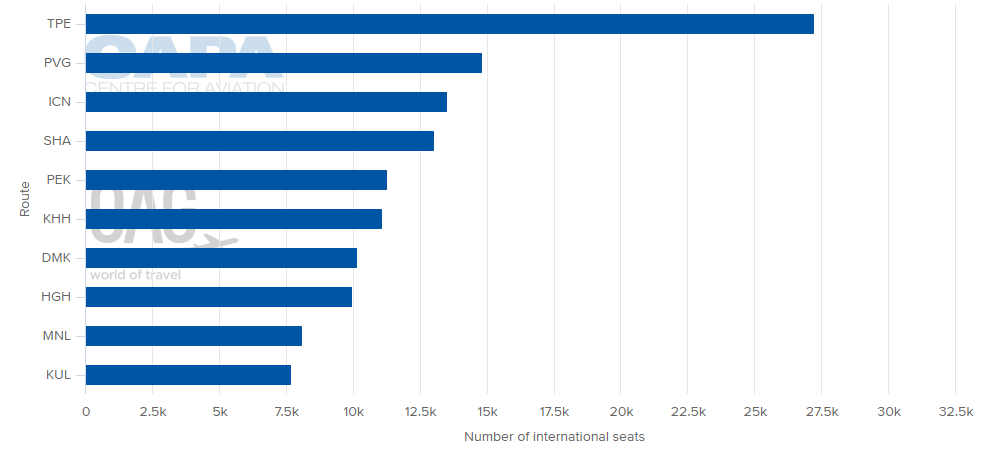Summary:
- Macau International airport reported its busiest month ever in Apr-2019 as it handled more than 800,000 passengers, up almost a fifth year-on-year;
- Growth is coming from the geographical locality in Asia, and developing charters would be one way of widening the airport's catchment base;
- Handling inbound traffic with a specific purpose (gambling) remains the airport's main business function.
With the continuous increase of routes and load factor accompanied by new airlines entering the market, strong growth was registered from mainland China (+33%), Southeast Asia (+13%) and Taiwan (+12%). Looking to 2Q2019, the airport said it will continue to develop a diversified aviation market, and "cooperate with airlines to develop more potential medium and long haul charter routes".
The airport is owned by the government and operated by Sociedade do Aeroporto Internacional de Macau S.A.R.L. There was previously some foreign participation but ANA Airports of Portugal sold its share back in 2011.
Macau (the Macao Special Administrative Region of the People's Republic of China), is a special administrative region on the western side of the Pearl River estuary in southern China. With a population of 650,000 and an area of 32.9 square kilometres, the former Portuguese colony is the most densely populated region in the world, even more so than nearby Hong Kong. It was returned to China in 1999.
Originally a sparsely populated collection of coastal islands, the territory has become a major resort city and the top destination globally for gambling tourism. It is the ninth-highest recipient of tourism revenue and its gaming industry is reputed to be seven times larger than that of Las Vegas. While the city has one of the highest per capita incomes in the world, it also has severe income inequality.
This ought to be reflected in its flight schedules. Passenger traffic has been rising inconsistently but steadily with growth rates varying from 6.4% to 15.3% during the last eight years. Air Macau is the largest carrier by seat capacity with 36% of seats and most of the capacity (64%) is on full-service carriers with LCCs weighing in on 35.9% and just 0.2% currently in the charter segment, which presumably is why the airport authority is targeting more charters.
CHART - Passenger traffic has been rising inconsistently, but steadily, at Macau International airport with growth rates varying from 6.4% to 15.3% during the last eight years Source: CAPA - Centre for Aviation and Macau International Airport reports
Source: CAPA - Centre for Aviation and Macau International Airport reports
Those LCCs are needed. Apart from the fact that even high rollers may be in need of one - particularly after big losses to the bank - there is little activity by alliance-member airlines at Macau, who will bring passengers in by way of the main routes such as Taipei, Shanghai and Seoul, only one of which (Seoul) can really be classed as a major global hub. Alliance member airlines account for only 16% of capacity presently.
CHART - The Taiwanese capital, Taipei, is the largest market served from Macau International airport; a similar level of capacity is offered to Shanghai, but split between the Chinese city's two airports Source: CAPA - Centre for Aviation and OAG (data: w/c 13-May-2019)
Source: CAPA - Centre for Aviation and OAG (data: w/c 13-May-2019)
The airport's route map is in fact heavily focused within a relatively small area stretching from Beijing, Seoul and Tokyo in the north to Singapore in the south. There are no long-haul services, no reciprocity with other gambling capitals like Las Vegas and Monte Carlo.
Again, the need to develop charters from the western hemisphere is evident. There is little evidence that a scheduled flight series, even from, say, London, Lisbon (capital of the old colonial power), the Middle East or India would be successful but ad-hoc and series charters are another story and the runway is long enough, at 3.3 km, to handle any aircraft type.
Many visitors arrive at Macau by way of sea ferry, turbojet and shuttle bus services from Hong Kong, which of course has the third-busiest airport in Asia and services from all over the world; or directly by helicopter from there. The two airports are only 66 km apart and cannot justify a scheduled air link. Gambling in Hong Kong is heavily regulated, but the presence of its international airport is actually the main impediment to Macau International's own growth.